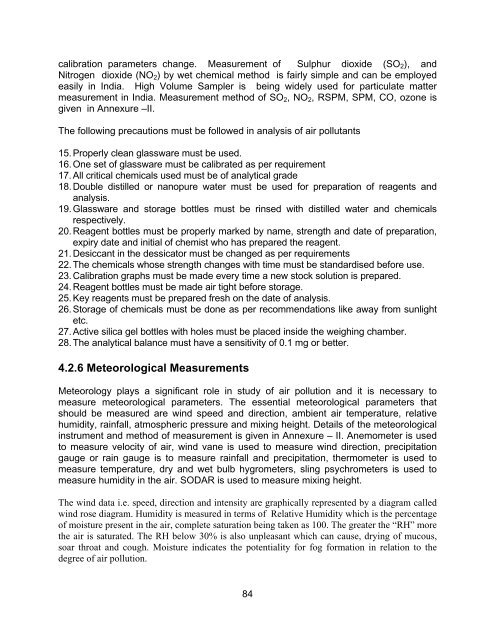Ambient Air quality Monitoring Guidlines. - Maharashtra Pollution ...
Ambient Air quality Monitoring Guidlines. - Maharashtra Pollution ...
Ambient Air quality Monitoring Guidlines. - Maharashtra Pollution ...
Create successful ePaper yourself
Turn your PDF publications into a flip-book with our unique Google optimized e-Paper software.
calibration parameters change. Measurement of Sulphur dioxide (SO2), and<br />
Nitrogen dioxide (NO2) by wet chemical method is fairly simple and can be employed<br />
easily in India. High Volume Sampler is being widely used for particulate matter<br />
measurement in India. Measurement method of SO2, NO2, RSPM, SPM, CO, ozone is<br />
given in Annexure –II.<br />
The following precautions must be followed in analysis of air pollutants<br />
15. Properly clean glassware must be used.<br />
16. One set of glassware must be calibrated as per requirement<br />
17. All critical chemicals used must be of analytical grade<br />
18. Double distilled or nanopure water must be used for preparation of reagents and<br />
analysis.<br />
19. Glassware and storage bottles must be rinsed with distilled water and chemicals<br />
respectively.<br />
20. Reagent bottles must be properly marked by name, strength and date of preparation,<br />
expiry date and initial of chemist who has prepared the reagent.<br />
21. Desiccant in the dessicator must be changed as per requirements<br />
22. The chemicals whose strength changes with time must be standardised before use.<br />
23. Calibration graphs must be made every time a new stock solution is prepared.<br />
24. Reagent bottles must be made air tight before storage.<br />
25. Key reagents must be prepared fresh on the date of analysis.<br />
26. Storage of chemicals must be done as per recommendations like away from sunlight<br />
etc.<br />
27. Active silica gel bottles with holes must be placed inside the weighing chamber.<br />
28. The analytical balance must have a sensitivity of 0.1 mg or better.<br />
4.2.6 Meteorological Measurements<br />
Meteorology plays a significant role in study of air pollution and it is necessary to<br />
measure meteorological parameters. The essential meteorological parameters that<br />
should be measured are wind speed and direction, ambient air temperature, relative<br />
humidity, rainfall, atmospheric pressure and mixing height. Details of the meteorological<br />
instrument and method of measurement is given in Annexure – II. Anemometer is used<br />
to measure velocity of air, wind vane is used to measure wind direction, precipitation<br />
gauge or rain gauge is to measure rainfall and precipitation, thermometer is used to<br />
measure temperature, dry and wet bulb hygrometers, sling psychrometers is used to<br />
measure humidity in the air. SODAR is used to measure mixing height.<br />
The wind data i.e. speed, direction and intensity are graphically represented by a diagram called<br />
wind rose diagram. Humidity is measured in terms of Relative Humidity which is the percentage<br />
of moisture present in the air, complete saturation being taken as 100. The greater the “RH” more<br />
the air is saturated. The RH below 30% is also unpleasant which can cause, drying of mucous,<br />
soar throat and cough. Moisture indicates the potentiality for fog formation in relation to the<br />
degree of air pollution.<br />
84
















